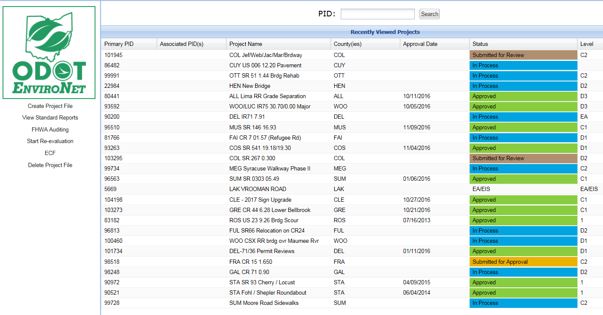The Ohio Department of Transportation (ODOT) has launched an expanded and renamed version of its online environmental documentation system and is steadily adding time-saving bells and whistles. The system, formerly known as CE Online, has been rebranded ENVIRONET to reflect the comprehensive capabilities of the system and to allow for future planned enhancements.
ENVIRONET facilitates the electronic processing of National Environmental Policy Act (NEPA) documents. Categorical exclusions (CEs) can be fully completed online because the forms are built into the system. The associated electronic project file houses supporting documentation. While Environmental Assessments (EAs) and Environmental Impact Statement (EISs) still need to be completed outside the system, both the environmental document and its associated documentation are uploaded to the electronic project file set up for the project.
The electronic project file is a very important part of the system since it allows real-time access to draft and final supporting documents. Subject matter reviewers can check out draft technical reports, make comments, and check them back in. Once the technical report is approved, it can be finalized in the system. This capability allows for version control and the system also tracks when documents were uploaded, when they were modified, and by whom.

EnviroNet System Screenshot, Courtesy Ohio DOT
The system also provides a standardized process for uploading reports, technical studies, agency coordination, and decision-making documents. It allows the user to select appropriate drop-down options to consistently name documentation. The process is capped off with an electronic review and approval function, meaning no printing, signing, scanning and uploading is required. Users have access to particular sections of the system based on their respective roles.
“Rebranding is a reminder that our system offers more than just streamlining CE preparations,” said ODOT Assistant Environmental Administrator Erica Schneider. “One of EnviroNet’s greatest benefits is that it provides all sorts of real-time information to our project team. There’s no longer a need for mailing or e-mailing information back and forth.”
ODOT has continued to save approximately $100,000 per year since its CE Online went live in 2012, Schneider said. Even better, savings could double as additional enhancements are added.
NEPA Assignment a Motivator
In December 2015, ODOT assumed federal authority for NEPA reviews from the Federal Highway Administration, giving the state agency added responsibilities for ensuring environmental compliance. These new responsibilities provided additional motivation to add new capabilities to the system, explained Kevin Davis, Environmental Supervisor with ODOT. For example, the system now includes a Project Details Tab that allows ODOT users to enter dates for specific environmental milestones related to the project, whether it’s a CE (the vast majority), EA, or an EIS.
“We now are required to closely track time savings,” he explained. “Using the project file, we can access completion dates for each stage of a project from start to finish. With these details in hand, we can identify exactly where we are saving time or, in some cases, exactly where we need to find ways to work more efficiently.”
Another recent addition is the FHWA Auditing Tool. During annual audits under the NEPA assignment program, auditors can log in at the home page, select the date range they are seeking, and view all of the documents approved during that time period.
Lessons Learned, Advice to Other DOTs
In planning and developing enhancements to ENVIRONET, ODOT has gathered suggestions from inside the agency and also used information from similar online systems in Pennsylvania, Virginia, and Texas. Virginia DOT, for example, has integrated a GIS component into its system, an enhancement ODOT now is considering.
Schneider said developing an effective system that can be built to grow and adapt requires funding, patience, and time. The original system cost about $600,000 to develop and it took just over a year.
She offered the following advice to other DOTs contemplating building similar systems:
- Gain and maintain strong support from upper management.
- Develop a front-end detailed communications plan. Processes, roles, and protocols should be clearly spelled out to avoid duplication and misunderstandings.
- Plan on dedicating a lot of time to working with programmers and subject matter experts as the system is developed.
- Involve everyday users of the system at the beginning of development. Learn about their needs and solicit their ideas. Before deployment, carry out user acceptance testing and make changes where needed.
- Provide comprehensive training to all users. Go beyond “train-the-trainer.” Conduct classroom training. Develop a website that provides guidance on tasks such as how to check out a document for review.
Looking Ahead
As of October 2016, more than 6,600 projects were housed in ENVIRONET including approved documents, those in process, and those submitted for review and/or approval. More than 600 people had been granted access to the system, including ODOT staff, regulatory agencies, and consultants. The eventual goal, Schneider said, is for all involved resource agencies to carry out their reviews using ENVIRONET and to make all approved environmental documents available to the public online.
Another planned enhancement will facilitate the completion and coordination of Ecological Survey Reports. Under the current system, regulatory agencies such as the U.S. Fish and Wildlife Service receive as many as 60-70 such reports a month. They are uploaded to an internal local drive and sent out in batches via an extranet site at the end of the month. The new feature, which would incorporate the report into the CE form, is scheduled for incorporation in 2017.
For more information, contact Kevin E. Davis at [email protected] or Erica Schneider at [email protected] of the Office of Environmental Services at ODOT or visit the Office of Environmental Services Environmental Documentation web page.